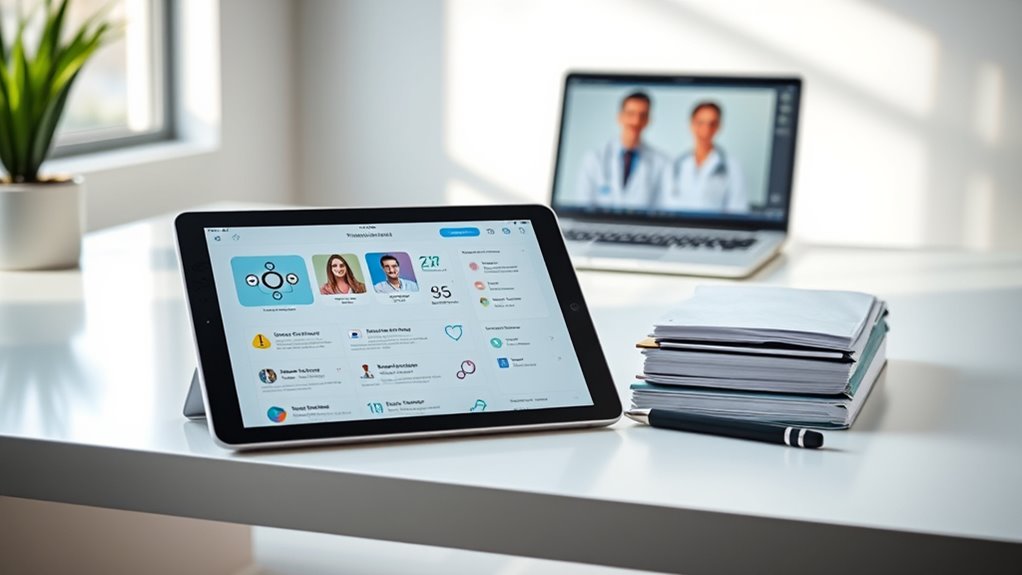To organize virtual visit documentation effectively, you should use secure electronic health record (EHR) systems designed for telehealth. Capture all relevant data, including clinical notes, lab results, and communications, in standardized templates to guarantee consistency. Automate categorization for easy retrieval and maintain compliance with regulations like HIPAA by enforcing encryption and access controls. By implementing these practices, you’ll ensure your records are accurate, secure, and compliant—discover more ways to optimize your telehealth documentation process.
Key Takeaways
- Implement standardized templates and protocols to ensure consistent, accurate documentation of telehealth virtual visits.
- Use secure electronic health record (EHR) systems designed for telehealth to organize and store all relevant data efficiently.
- Automate data tagging and categorization to facilitate quick retrieval and streamline audit processes.
- Maintain compliance by encrypting data, enforcing secure logins, and adhering to regulations like HIPAA.
- Create a centralized, secure digital ecosystem that supports real-time updates, easy access, and ongoing telehealth growth.

Have you ever wondered how telehealth is transforming the way we handle medical records? As telehealth becomes more prevalent, managing digital documentation for remote patients has taken center stage. You’re now responsible for guaranteeing that every virtual visit is accurately documented, securely stored, and easily accessible. This shift requires a new approach to organizing medical records, one that emphasizes efficiency and compliance with digital standards. When dealing with remote patients, the importance of maintaining proper records goes beyond traditional files; it involves integrating digital compliance protocols to protect sensitive information and meet regulatory requirements.
In the virtual environment, every interaction counts. You need a system that captures all relevant data from remote patient encounters—clinical notes, lab results, imaging, prescriptions, and patient communications. These records must be organized in a way that’s intuitive and compliant with healthcare regulations like HIPAA. Digital compliance isn’t just about security; it’s about creating a seamless workflow that ensures data integrity and privacy. Implementing electronic health records (EHR) systems designed for telehealth makes it easier to track and manage these documents. These platforms facilitate real-time updates, secure sharing, and audit trails that help you monitor compliance and address any issues promptly.
Another key aspect is the standardization of documentation processes. With remote patients, you may encounter diverse platforms for virtual visits, each generating different types of data. To keep everything organized, you need uniform templates and protocols for documenting each encounter. This helps prevent errors, reduces duplication, and ensures consistency across your records. Automated tools can assist in tagging and categorizing data, making retrieval straightforward and efficient. When every record is properly organized, you save time during audits or when referencing past visits, which ultimately improves patient care and operational efficiency.
Moreover, staying current with digital compliance guidelines is vital. Laws and regulations surrounding telehealth records are continually evolving, so you must regularly update your practices. This means encrypting data, implementing secure login procedures, and restricting access to authorized personnel only. Properly organized digital records also support billing and reimbursement processes, reducing delays caused by incomplete or poorly documented visits. By maintaining meticulous, compliant records for your remote patients, you’re not only protecting their privacy but also safeguarding your practice against legal risks.
A deeper understanding of contrast ratio and its impact on image quality can help you optimize your telehealth setup, ensuring clear visuals when sharing diagnostic images or video consultations. In essence, effective organization of virtual visit documentation hinges on understanding the unique needs of remote patient care and applying rigorous digital compliance standards. You’re tasked with creating a digital ecosystem where every piece of information is securely stored, easily retrievable, and fully compliant. As telehealth continues to grow, mastering these practices will be essential for delivering quality care while managing the complex landscape of digital health records.
Frequently Asked Questions
How Secure Are Telehealth Medical Records Against Hacking?
Your telehealth medical records are generally secure if encryption protocols are properly implemented, making data interception difficult for hackers. However, no system is completely invulnerable. To minimize risks, verify your provider follows strict data breach prevention measures, including regular security updates and secure authentication. Staying informed and using strong, unique passwords further helps protect your records against hacking attempts.
Can Patients Access and Edit Their Telehealth Documentation?
You can access your telehealth documentation, and in some cases, you might even edit it, depending on your provider’s system. It’s important to remember that patient privacy is a top priority, so access is usually protected. Record accessibility varies, but many platforms now offer patient portals that let you review your records securely. Always check with your provider to understand your rights and the platform’s capabilities.
What Are the Legal Requirements for Storing Virtual Visit Records?
You must follow legal requirements for storing virtual visit records, including ensuring data privacy and proper record retention. Laws vary by jurisdiction, but generally, you’re expected to securely store and protect patient information against unauthorized access. Keep records for the mandated period, often several years, and make sure your storage methods comply with regulations like HIPAA. Regularly review your practices to maintain legal compliance and safeguard patient confidentiality.
How Do Telehealth Records Integrate With Traditional Medical Records Systems?
Integrating telehealth records with traditional systems is like fitting puzzle pieces together seamlessly. You guarantee digital interoperability by using compatible platforms and standardized formats, allowing records to flow smoothly between virtual and in-person documentation. Focus on documentation accuracy to prevent gaps or errors. This integration streamlines patient care, maintains extensive medical histories, and enhances data security, making it easier to access and share information across all healthcare settings.
What Standards Ensure Consistency Across Different Telehealth Platforms?
You rely on interoperability standards like HL7 and FHIR to guarantee consistency across telehealth platforms. These standards promote data format consistency, making it easier to share and access medical records seamlessly. By adhering to these guidelines, you can assure that information remains accurate and compatible, regardless of the platform used. This promotes smoother virtual visits and improves overall patient care, ensuring your telehealth system remains efficient and reliable.
Conclusion
By mastering the organization of your telehealth and medical records, you’re not just staying ahead—you’re revolutionizing healthcare itself! Imagine a world where every virtual visit is perfectly documented in seconds, preventing errors and saving lives. When you get serious about your records, you’re wielding the power to transform patient care forever. Don’t settle for chaos—take charge now, and make your virtual healthcare system unstoppable!









